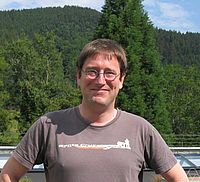Prof. Dr. Hartmut Weiss
Project leader

Christian-Albrechts-Universität zu Kiel
E-mail: weiss(at)math.uni-kiel.de
Telephone: +49 431 880-2790
Homepage: https://www.math.uni-kiel.de/geometrie/d…
Project
32Asymptotic geometry of the Higgs bundle moduli space
77Asymptotic geometry of the Higgs bundle moduli space II
Publications within SPP2026
Given a generic stable strongly parabolic $SL(2,\mathbb{C})$-Higgs bundle
$(\mathcal{E}, \varphi)$, we describe the family of harmonic metrics $h_t$ for
the ray of Higgs bundles $(\mathcal{E}, t \varphi)$ for $t\gg0$ by perturbing
from an explicitly constructed family of approximate solutions
$h_t^{\mathrm{app}}$. We then describe the natural hyperK\"ahler metric on
$\mathcal{M}$ by comparing it to a simpler "semi-flat" hyperK\"ahler metric. We
prove that $g_{L^2} - g_{\mathrm{sf}} = O(\mathrm{e}^{-\gamma t})$ along a
generic ray, proving a version of Gaiotto-Moore-Neitzke's conjecture.
Our results extend to weakly parabolic $SL(2,\mathbb{C})$-Higgs bundles as
well.
In the case of the four-puncture sphere, we describe the moduli space and
metric more explicitly. In this case, we prove that the hyperk\"ahler metric is
ALG and show that the rate of exponential decay is the conjectured optimal one,
$\gamma=4L$, where $L$ is the length of the shortest geodesic on the base curve
measured in the singular flat metric $|\mathrm{det}\, \varphi|$.
| Pages | 73 pages |
| Link to preprint version |
Related project(s):
32Asymptotic geometry of the Higgs bundle moduli space
We study the asymptotics of the natural \(L^2\) metric on the Hitchin moduli space with group \(G=SU(2)\). Our main result, which addresses a detailed conjectural picture made by Gaiotto, Neitzke and Moore, is that on the regular part of the Hitchin system, this metric is well-approximated by the semiflat metric. We prove that the asymptotic rate of convergence for gauged tangent vectors to the moduli space has a precise polynomial expansion, and hence that the the difference between the two sets of metric coefficients in a certain natural coordinate system also has polynomial decay. Very recent work by Dumas and Neitzke indicates that the convergence rate for the metric is exponential, at least in certain directions.
| Journal | Comm. Math. Phys. |
| Publisher | Springer |
| Volume | 367, no. 1 |
| Pages | 151-191 |
| Link to preprint version | |
| Link to published version |
Related project(s):
32Asymptotic geometry of the Higgs bundle moduli space
We prove a gluing theorem for solutions \((A_0, \Phi_0)\) of Hitchin's self-duality equations with logarithmic singularities on a rank-\(2\) vector bundle over a noded Riemann surface \( \Sigma\) representing a boundary point of Teichmüller moduli space. We show that every nearby smooth Riemann surface \( \Sigma_1\) carries a smooth solution \((A_1, \Phi_1)\) of the self-duality equations, which may be viewed as a desingularization of \((A_0, \Phi_0)\).
| Journal | Adv. Math. |
| Publisher | Elsevier |
| Volume | 322 |
| Pages | 637-681 |
| Link to preprint version | |
| Link to published version |
Related project(s):
32Asymptotic geometry of the Higgs bundle moduli space
We associate to each stable Higgs pair \((A_0,\Phi_0)\) on a compact Riemann surface X a singular limiting configuration \((A_\infty,\Phi_\infty)\), assuming that \(\det\Phi\) has only simple zeroes. We then prove a desingularization theorem by constructing a family of solutions \((A_t,\Phi_t) \) to Hitchin's equations which converge to this limiting configuration as \(t\to\infty\). This provides a new proof, via gluing methods, for elements in the ends of the Higgs bundle moduli space and identifies a dense open subset of the boundary of the compactification of this moduli space.
| Journal | Duke Math. J. |
| Publisher | Duke University Press |
| Volume | 165 |
| Pages | 2227-2271 |
| Link to preprint version | |
| Link to published version |
Related project(s):
32Asymptotic geometry of the Higgs bundle moduli space

